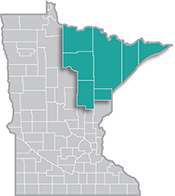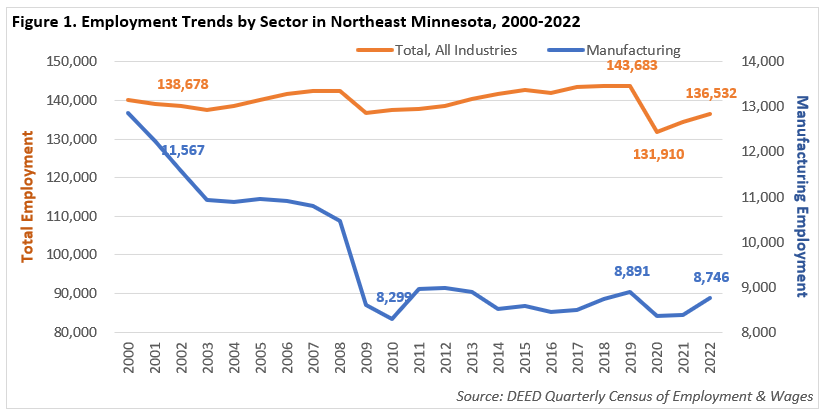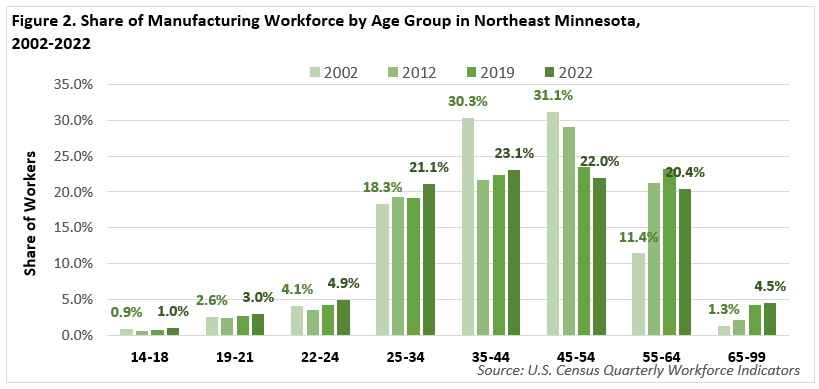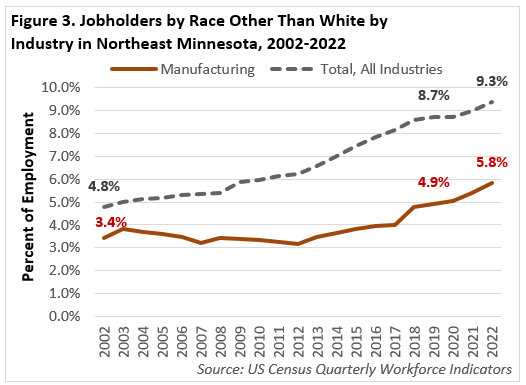 Home to the state's second-largest metro, the Northeast Region has a strong industrial sector, tied largely to the area's abundant natural resources.
Home to the state's second-largest metro, the Northeast Region has a strong industrial sector, tied largely to the area's abundant natural resources.
Most of the manufacturing base centers on mining and forest products industries. More than half of the sector's employment is in paper and machinery manufacturing.
Want the freshest data delivered by email? Subscribe to our regional newsletters.
9/15/2023 9:00:00 AM
Carson Gorecki
It is well documented that the workforce in Northeast Minnesota has been undergoing significant changes over the past two decades, as well as over the more recent pandemic period. The regional population has been growing slowly and aging. These trends have manifested even more clearly in the labor force as well as across many industry sectors such as Manufacturing where there is a continued need for workers.
The Manufacturing sector in Northeast Minnesota produces a varying array of goods including everything from airplanes to paper and beverages. Recognition of the vital role Manufacturing plays in the local economy was acknowledged in the City of Duluth's recent acceptance into the Good Jobs, Great Cities Academy.
The Manufacturing sector accounted for 8,930 jobs across 338 establishments in Northeast in the first quarter of 2023. That was good for 6.2% of all employment in the region, making Manufacturing the sixth largest sector out of 20, behind Health Care & Social Assistance, Retail Trade, Accommodation & Food Services, Educational Services, and Public Administration. Manufacturing jobs paid an average annual wage of $68,480 in 2022, about $14,000 per year above the all-industry average.
The region's economy has seen significant changes over the past two decades, including a severe drop in employment due to the Pandemic Recession. Relative to all industries, Manufacturing fared better than average, which was a big reversal from the dynamics of the previous two recessions when Manufacturing was one of the hardest hit sectors (see Figure 1).

Compared to the average job count in 2019, Manufacturing employment was down -1.6% (-145 jobs). Total employment in the region, meanwhile, was still down -5% (-7,151 jobs) in 2022 as industries more dependent upon direct social interaction took the brunt of the pandemic-related impacts. Since the depth of the recession, Manufacturing has added nearly 400 jobs, an increase of 4.8% and a recovery that was also above the all-industry average. While down over the longer-term, Manufacturing employment has been relatively stable over the last decade and even grew into and out of the pandemic.
In addition to the overall number of people employed in Manufacturing, the employees themselves have also changed over time. The biggest transformation has been the distribution of workers by age. In 2002, 61.4% of Manufacturing workers were between the ages of 35 and 54. Twenty years later the distribution is much more even as just over 20% of workers occupy each of the four ten-year cohorts between 25 and 64. So while the 35-44 and 45-54 cohorts' percentages declined, they increased for every other age group. The 65+ cohort saw its share of employees grow the most (+258%) over two decades, followed by the 55-64 age group (+79%) (see Figure 2).

The share of workers under 35 expanded 16% over the same period. More recently, the growth of the youngest cohorts continued, and jobs held by teenagers even accelerated from 2019 to 2022. For the older cohorts however, growth slowed, or in the case of 55–64-year-old workers, reversed course and started to decline as workers left the industry or retired.
Northeast Minnesota's Manufacturing workforce has also been diversifying racially and ethnically. While less diverse than the regional workforce at large, the sector has added workers of color even as the total number of jobs declined. In 2002, workers of color accounted for 3.4% of Manufacturing jobs in the region. That share held roughly steady through the mid-2010s before jumping to 5% in 2018, and then increasing to 5.8% in 2022 (see Figure 3). In fact, most of the employment growth since 2019 can be attributed to a diversifying Manufacturing workforce. White employment fell 3% just as jobs held by Black, Indigenous and People of Color expanded by 16%.

Another notable trend in the Manufacturing workforce has been the decrease in the share of female workers. Since 2003, the share of women workers in Manufacturing fell from 24.5% to 21% in 2022. Following the Great Recession, there was a rebound to 22.3% in 2019, but the share fell more than a percentage point over the next three years. This occurred as the share of female employment overall fell from 50.4% in 2019 to 49.9% in 2022, a smaller decline than what Manufacturing experienced (see Figure 4).

However, at the same time, the women that did work in the Manufacturing sector saw their wages grow faster than their male counterparts, chipping away at an existing gender pay gap. From 2019 to 2022 the median wage for women in Manufacturing grew 21.6%, which was about six percentage points higher than the wage growth for men.
While the Manufacturing workforce undergoes changes, one thing remains constant: the need for more workers. As the current workforce continues to age, the demand for the next generation of Manufacturing workers will rise. Population, labor force, and industry trends point toward a workforce that looks different from the Manufacturing workforce of twenty years ago.
Contact Carson Gorecki, Labor Market Analyst, at carson.gorecki@state.mn.us.